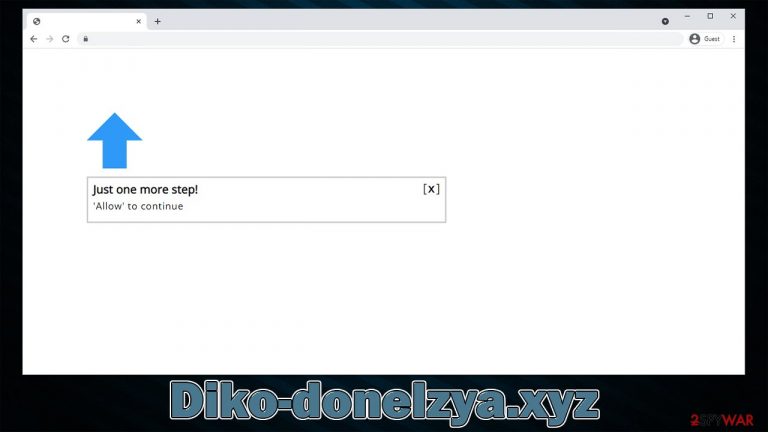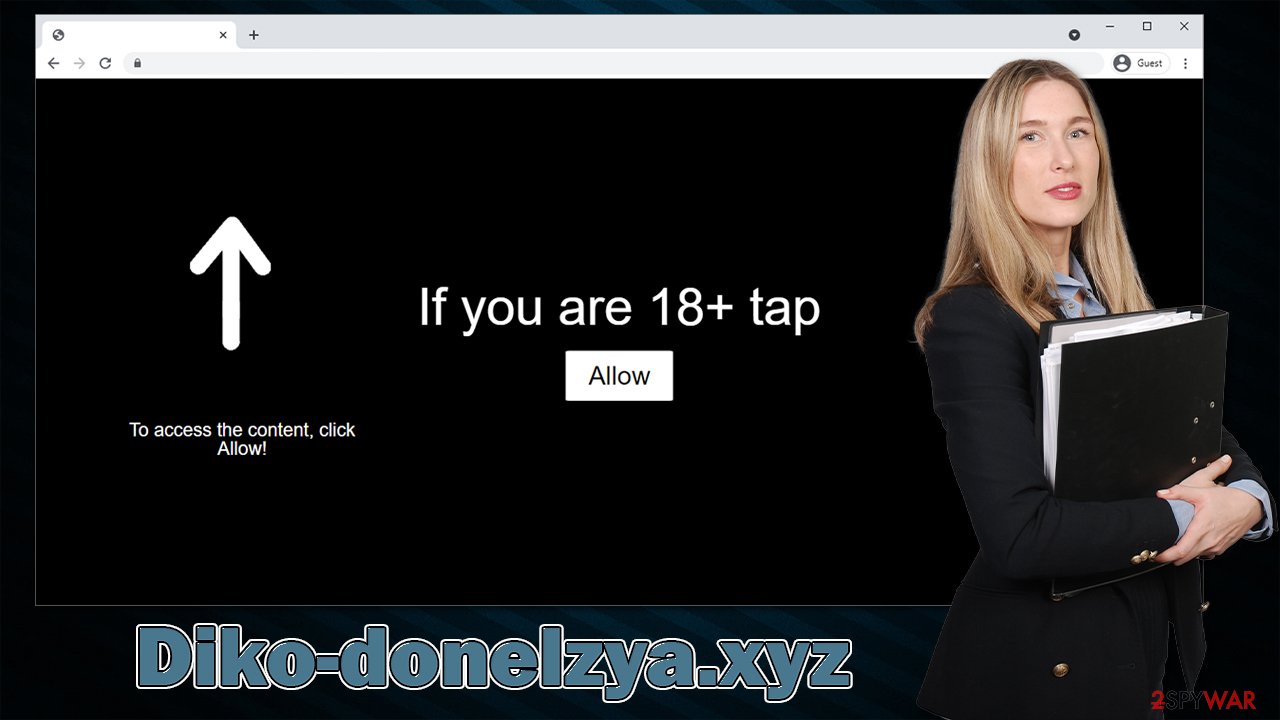Diko-donelzya.xyz ads (scam) - Free Instructions
Diko-donelzya.xyz ads Removal Guide
What is Diko-donelzya.xyz ads?
Diko-donelzya.xyz asks to enable push notifications so it could deliver intrusive ads later

Diko-donelzya.xyz is a fake website that deliberately tries to represent a legitimate browser feature as something else, only to later benefit from advertising revenue later. Scammers create fake websites regularly and push notification scams are extremely prevalent, especially when visiting high-risk websites such as illegal video streaming platforms or pirated software distribution websites. In some cases, users may also encounter a phishing[1] website whenever their systems are infected with adware, a type of potentially unwanted software that specializes in the delivery of ads.
Those who get tricked by the misleading Diko-donelzya.xyz messages would initially not notice any differences, apart from likely being redirected to other scam sites like Tidywarden.store, News-xokise.cc, Safeprotect.info, and many others. Only sometime later would people notice the intrusive pop-ups with dubious content showing up on their screens. However, since they have been tricked into subscribing, they can't tell the source of these annoying notifications. Luckily, it is not that difficult to stop this activity – just follow the guide below.
| Name | Diko-donelzya.xyz |
| Type | Push notifications, ads, pop-ups, scam |
| Distribution | Intrusive pop-ups can start showing up at some point after the “Allow” button is pressed within the notification prompt |
| Symptoms | Pop-ups show up on a regular basis on the screen – these ads often include inappropriate, scam, phishing, or other similar content |
| Risks | The ads shown within push notifications might include misleading messages and links to malicious websites. If clicked, you might end up infecting your system with malware, disclosing your personal information, or losing money |
| Removal | Access browser settings to stop intrusive push notifications. After that, make sure that your system is not infected with adware or malware – scan it with SpyHunter 5Combo Cleaner |
| Other tips | Do not forget to clean your browsers properly to avoid the return of ads and further data tracking. You can also repair damaged system files with FortectIntego |
What are push notifications, and how do they work?
The concept of push notifications is still poorly understood by many users, even though requests to enable them are very prevalent. This can be attributed to two main reasons:
- The feature was first introduced on desktop browsers in 2015, evolving from the notifications people are used to seeing on their mobile devices such as phones or tablets;
- Despite being offered on many websites, over 99% of users do not interact with the request when such is presented upon the website entry, according to a study by Mozilla found in 2019.[2]
In reality, the principle of the push notification feature is very simple: website authors can offer users to allow notifications to be shown, and if they do, any kind of information can then be sent to users' desktops via the browser's API.[3] For this to be working, users need to have browsers running and don't have to be actively using them at the time.
The feature seems good on paper, as it allows various websites to promote their content, increasing traffic, and it can benefit users who want to access the latest information from the said site immediately. However, in practice, push notifications are often misused to send users adverts that are highly monetized. Diko-donelzya.xyz is just one of many websites that abuse this feature by showing users misleading messages for them to enable the push notifications.
How users get scammed
The unexpected redirect to Diko-donelzya.xyz is clearly something that helps scammers to fulfill their goals, as users tend to think little about what they see next. The main goal is to confuse people and make them believe that the push notification prompt is something entirely different and unrelated to the purpose it actually fulfills.
For the scene to be successful, various misleading messages are used, and they are asking people to confirm their age or that they aren't robots. These requests are very prevalent and can be encountered under certain circumstances; for example, bypassing captcha codes or selecting the right images become an accustomed practice. However, requests here are entirely fabricated and are only made to deceive users – here are a few examples:
- If you are 18+, click Allow
- Click Allow to confirm that you are not a robot
- Click “Allow” to win the prize and get it in our shop!
- Press “Allow” to watch the video
- Click Allow to start downloading.

It is not difficult to see how some users might get confused or don't even think about it much and press the “Allow” button within the notification prompt. Even if you have allowed notifications from a malicious site, it is not a big deal if you do not interact with the promoted content – you can remove them rather easily.
Removal of unwanted push notifications from Diko-donelzya.xyz
Since users are introduced to intrusive push notifications via the scam scheme, they are often confused about where this activity is coming from and what is causing it. Many assume that their systems have been infected with some kind of virus since suspicious pop-ups would usually indicate it's the case. When looking for these infections, they attempt to scan their devices with security software, but to no avail.
In order to remove Diko-donelzya.xyz ads, one would have to access browser settings and then block the related URL from sending push notifications. Here's how:
Google Chrome (desktop)
- Open the Google Chrome browser and go to Menu > Settings.
- Scroll down and click on Advanced.
- Locate the Privacy and security section and pick Site Settings > Notifications.
- Look at the Allow section and look for a suspicious URL.
- Click the three vertical dots next to it and pick Block. This should remove unwanted notifications from Google Chrome.

Google Chrome (Android)
- Open Google Chrome and tap on Settings (three vertical dots).
- Select Notifications.
- Scroll down to the Sites section.
- Locate the unwanted URL and toggle the button to the left (Off setting).

Mozilla Firefox
- Open Mozilla Firefox and go to Menu > Options.
- Click on Privacy & Security section.
- Under Permissions, you should be able to see Notifications. Click the Settings button next to it.
- In the Settings – Notification Permissions window, click on the drop-down menu by the URL in question.
- Select Block and then click on Save Changes. This should remove unwanted notifications from Mozilla Firefox.

MS Edge (Chromium)
- Open Microsoft Edge, and go to Settings.
- Select Site permissions.
- Go to Notifications on the right.
- Under Allow, you will find the unwanted entry.
- Click on More actions and select Block.

Safari
- Click on Safari > Preferences…
- Go to the Websites tab and, under General, select Notifications.
- Select the web address in question, click the drop-down menu and select Deny.

Internet Explorer
- Open Internet Explorer, and click on the Gear icon at the top-right of the window.
- Select Internet options and go to the Privacy tab.
- In the Pop-up Blocker section, click on Settings.

- Locate the web address in question under Allowed sites and pick Remove.
Don't forget to check your system for adware
We strongly recommend you perform additional checks when dealing with unexpected pop-ups, redirects, or intrusive advertisements. Adware is one of the most common potentially unwanted applications that cause unwanted activity, although sometimes it may emit no symptoms at all.
Therefore, the easiest way to secure your system is to scan it with SpyHunter 5Combo Cleaner or Malwarebytes security software – it can find all the malicious files and other components, consequently quarantining and removing them all at once. Besides, anti-malware is necessary to protect yourself from incoming attacks in the future. After you are sure no PUPs or malware is present, then make sure you clean your browsers and fix virus damage with FortectIntego for best results.
How to prevent from getting adware
Protect your privacy – employ a VPN
There are several ways how to make your online time more private – you can access an incognito tab. However, there is no secret that even in this mode, you are tracked for advertising purposes. There is a way to add an extra layer of protection and create a completely anonymous web browsing practice with the help of Private Internet Access VPN. This software reroutes traffic through different servers, thus leaving your IP address and geolocation in disguise. Besides, it is based on a strict no-log policy, meaning that no data will be recorded, leaked, and available for both first and third parties. The combination of a secure web browser and Private Internet Access VPN will let you browse the Internet without a feeling of being spied or targeted by criminals.
No backups? No problem. Use a data recovery tool
If you wonder how data loss can occur, you should not look any further for answers – human errors, malware attacks, hardware failures, power cuts, natural disasters, or even simple negligence. In some cases, lost files are extremely important, and many straight out panic when such an unfortunate course of events happen. Due to this, you should always ensure that you prepare proper data backups on a regular basis.
If you were caught by surprise and did not have any backups to restore your files from, not everything is lost. Data Recovery Pro is one of the leading file recovery solutions you can find on the market – it is likely to restore even lost emails or data located on an external device.
- ^ Phishing attacks. Imperva. Application and data security.
- ^ M.J. Kelly. Say goodbye to annoying notification requests (unless you want them). Mozilla. Distilled blog.
- ^ Application Programming Interface (API). IBM. Cloud Learn Hub.
